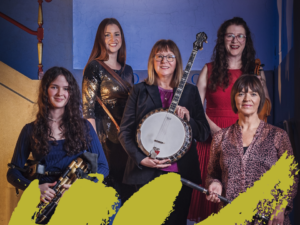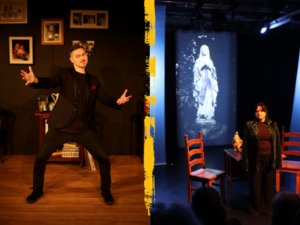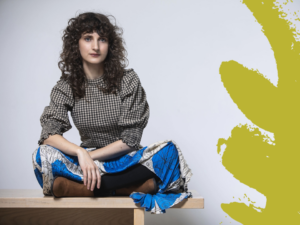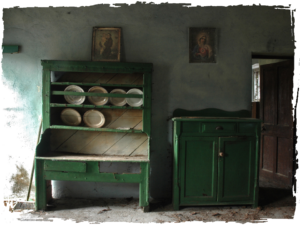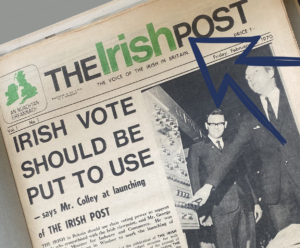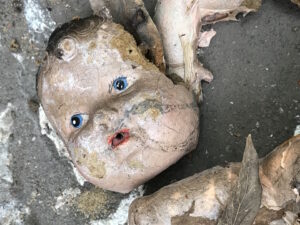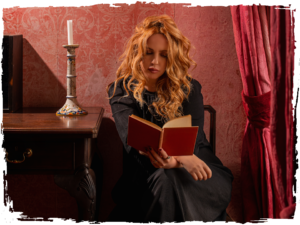
Nightvisiting, a new show from Irish folk singer, actor and folklorist Lisa Lambe will feature at The Tung Auditorium, Liverpool, Fri 20 Oct 2023 as part of the Liverpool Irish Festival.
It’s the first time Lisa will deliver live performances of this music outside of Ireland. The show embraces the old tradition of gathering around the hearth of an Irish home. This tradition peaked after An Gorta Mór (1850s) and slowed as electricity came to rural Ireland (1940s). In Latin, the word ‘Communitas’ meant the sharing and intimacy developed among people who experience liminality as a group. Nightvisiting embodies this concept.
Lisa’s show reimagines and celebrates the communal songs and stories, sung and recited by hearthside. It covers songs of loss and grief; songs and tunes of the Irish Famine; songs of emigration, love and marriage. Below, Lisa Lambe interrogates Nightvisiting, sharing a little of what make this music so poignant.
Bothántaíocht, scoraíochting, airneáin
- Bothántaíocht – going to visit summer houses in the hill; for entertainment at nighttime, connected with transhumance (seasonal movement of livestock)
- Scóraíocht – nighttime gathering for entertainment
- Airneáin – nightvisiting for storytelling, singing and dancing.
Article contents
Use these links to move through the article. Alternatively, use the up arrow (^) in the circle, at the bottom of your screen, to return to the top.
- Visiting in the context of the Irish Famine (1845-52)
- The dark
- Protection
- The Nightvisit
- Partnership
- Footnotes.
Visiting: in the context of the Irish Famine (1845-52)
In 1850, the collector and antiquarian George Petrie (b. Dublin 1790, d. Dubin1866) noted that an “awful unwonted silence” consumed the land of Ireland”[1].
Music had died out and a dreadful silence fell over the land. The collective and communal memory -of those consumed by the Irish Famine- were too traumatised to speak and few wanted to listen. The voices were underfoot.
The songs and stories, which once painted the moonlit roadsides and boreens (natural country roads) in rural Ireland, were slowly being erased by the Great Hunger. Oftentimes, memory -and a separation from home- is what encouraged those outside Ireland (who made it beyond the coffin ships) to sing; to write down and to remember those songs that were part of the ordinary and the everyday.
The dark
In the years after An Gorta Mór, men and women -and boys and girls- might take their bicycle to a nearby rambling house (the house holding the Nightvisit) using their local boreens. There they’d talk and share the old songs; the stories; the gossip of the town, the village or the area.
Sometimes the lady of the house served tea with a substantial slice of brown bread. Cards were played; music was made; songs were sung. It is noted in one account, from County Leitrim (from The National Folklore Collection), that the ramblers would leave for the boreen and road home ‘at around 10 o’clock’. With the weather being so cold it was said ‘I’m sure they get perished along the way’.
The road home was the same boreen, the same path, walked by thousands to coffin ships 175 years ago.
On these roadsides, it was said that a lot of interactions happened with The Otherworld; including ‘The Good People’ (the fairies) after dark. Before electricity -often with only moonlight lighting the road home- there were many happenings, remembered and shared with neighbours and crafted in to into handwritten manuscripts by visiting collectors.
Protection
Often times, a man travelling the road home alone, would carry crumbs in his pocket for fear of ‘The Hungry Grass’. If he came upon ‘The Hungry Grass’, he would fall. Only by placing the breadcrumbs on the grass -in honour of the Irish Famine voices underfoot- would he be able to stand up and continue his onward journey. There are many stories of The Good People asking for a game of cards or inviting those they meet to a hurling match challenge. Many with magical twists.
Those who remained in Ireland remembered those lost daily. They recalled the ‘American wakes’; the sad and angry ballads; the oldest and the saddest songs and lamentations of farewell. It is something that could easily be evoked in America -or Liverpool- for those Irish who left and never returned.
The Nightvisit
For many, the Nightvisit was the beating heart of the community. They provided a time to gather, and feel part of a community. With many songs of loss in the Irish repertoire, songs of love also appeared in abundance. The oldest Gaelic love song Dónal Óg[2] features in the Nightvisiting show, accompanied many other beautiful songs, including Blackwaterside, The Galway Shawl, Skibbereen, Matt Hyland and The Parting Glass. These are interweaved with many magical moments from tunes from County Clare, including Junior Crehan’s Favourite, also known as Knot on the Cord.
When asked about the genesis of the show, I say:
“Nightvisiting is what our ancestors did every evening, before the rural electrification of Ireland. With my show, I want to take the audience back 80-, 90-, 100 -years with the songs. I offer the context of the material alongside stories of the Famine. Of love, of emigration, of marriages and of farewell… The musicians accompanying me (Mike Brookfield, Tim Doyle and Claire Sherry) evoke the soundscape. From underscore, to tunes, to songs… the stories take us down those boreens and allow us all -in a modern auditorium- to go Nightvisiting. It’s a concept I hope to continue to develop. I’m evolving it on an on-going basis. I am so honoured to be coming to Liverpool with the show. There I’ll remember the Famine, within the material, and allow the audience a moment with it to remember”.
In the heart of Liverpool, a city that witnessed the arrival of almost 1.3-million Irish, Nightvisiting pays homage to the resilience of the music and stories.
Partnership
This event is delivered with The Institute of Irish Studies at University of Liverpool. Special thanks go to Gerry Diver, Lisa Lambe and her team, who’ve helped to make this article and event happen. Additional thanks go to the staff at The Tung Auditorium.
For more information about Lisa Lambe and her band, visit her website
Footnotes
[1] George Petrie, The Ancient Music of Ireland, Vol. 1, Dublin: Society for the Preservation and Publication of the Melodies of Ireland, 1855, p. 21.
[2] Translation: Young Donald. The song dates back to the eighth century and has several famous translations. At its root, it’s a song handling the heartbreak of a young woman.

